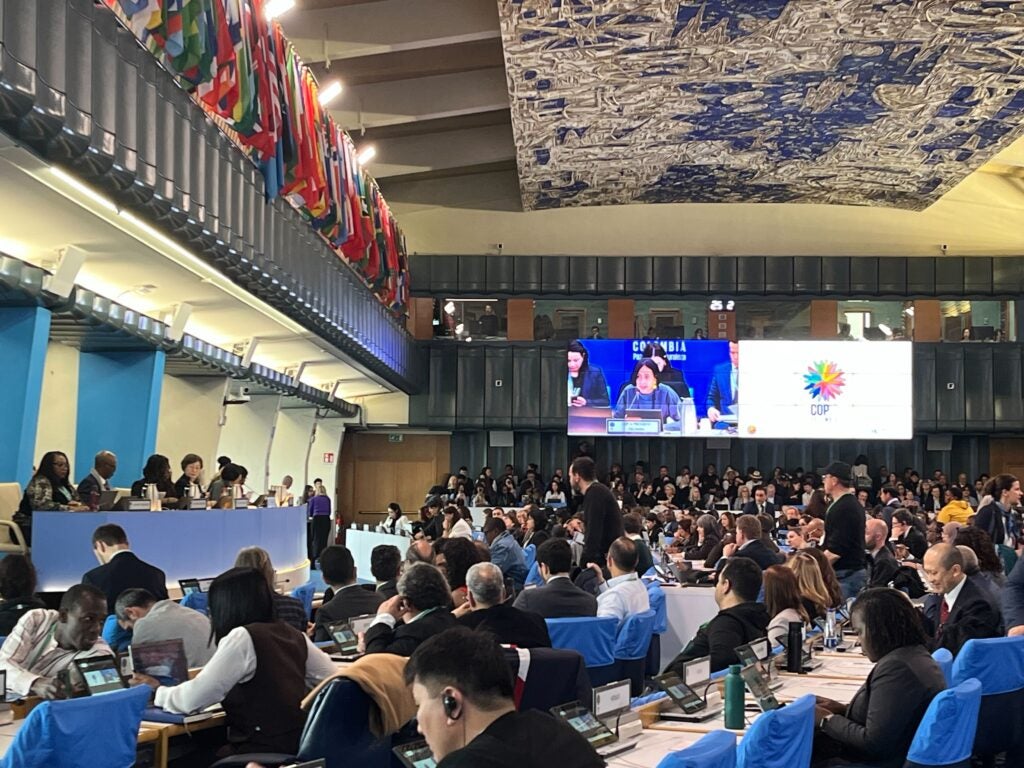
COP16.2 plenary in Rome
This blog was authored by Milloni Doshi, Project Manager, Global Engagement and Partnerships and Annie Mark, Senior Director, Global Partnerships.
The 16th Conference of the Parties of the United Nations Convention on Biological Diversity (CBD COP16) concluded in Rome with what is being hailed as a historic global finance plan to support the Kunming-Montreal Global Biodiversity Framework, agreed at COP15 in 2022.
The first of its kind in the biodiversity space, this financial plan was the subject of tense discussion and remained unresolved after the first session of COP16 in Cali, Colombia. Parties diverged on the funding mechanisms needed to mobilize at least 200 billion USD a year by 2030. Colombia’s COP President Susana Muhamad reconvened the Parties in Rome for a three-day sprint – referred to as COP16.2 – to resolve the outstanding issues from Cali.
Amid the nuances of the text, EDF sees three key reasons for optimism, and three opportunities to strengthen this endeavor as we look ahead to COP17 and the 2030 targets.
1. Environmental Cooperation is possible
Negotiators bridged differences, securing full consensus on all three agenda items – resource mobilization, finance mechanisms, and the monitoring framework. In the context of global geopolitical tensions spilling over into UN forums, consensus cannot be taken for granted. COP16 is now a model for achieving multilateral progress in this fast-changing world.
2. Leadership and Integrity in dealmaking
In a year marred by intense geopolitical conflict, the Colombian COP16 Presidency rose to the occasion. COP16 President Susana Muhamad consistently advocated for an inclusive approach, creating the “people’s COP.” The results speak for themselves, with landmark achievements including the new permanent subsidiary body for Indigenous Peoples and Local Communities (IPs and LCs) and the establishment of the Cali Fund. Ahead of Rome, the Presidency crafted a reflection note that balanced ambition with diverse viewpoints, setting the stage for constructive discussions and ultimately, successful outcomes.
3. Role of Trust
Building on seemingly unanimous trust in the COP President, Parties also appeared to trust each other’s good (enough) intentions. Delegates appeared to negotiate in good faith, repeatedly invoking the need for collaboration and compromise – a noted departure from many of the tensions that marred the climate COP29 in Baku only months prior. Even in moments where disagreement was palpable – most notably between developed and developing countries on the issue of a new finance mechanism – Parties remained largely conciliatory. For example, Senegal, on behalf of the African Group, expressed appreciation for the resources that were provided for capacity building and enhancing of the bloc’s coordination.
Opportunities ahead
- Implementation. As Astrid Schomaker, Executive Secretary of the Convention on Biological Diversity said, “Environmental Multilateralism is alive but also relies on actions taken at home.” While COP16 achieved a successful first step, implementation hinges on actions taken in the coming years. Most notably, the Parties circumvented the issue of a new finance mechanism by creating a road map to resolving this issue fully by COP19 in 2030 – a timeline inherently at odds with achieving 2030 targets. With a significant financing gap looming, and donor countries announcing aid budget cuts – the situation is tense. It is crucial for donor counties to actively communicate their strategies to meet their financial obligations; and for all Parties to submit strong National Biodiversity Strategies and Action Plans.
- Inclusion. The reconvened COP included key constituencies, including youth, women, and Indigenous Peoples and Local Communities. However, their participation was largely confined to closed-door side sessions. In her closing remarks, the Women’s delegate noted that she made a single one-minute intervention during the three-day session. Others noted Afro-Descendents still seek proper representation in the Convention. Concerningly, some Parties removed language about respecting human rights and the rights of Indigenous Peoples and Local Communities. As conservation efforts shift to rights-based models and approaches, the Convention should align accordingly.
- Creating real access for real impact. While the texts allocate significant resources to IPs and LCs (20% from the GBFF and 50% from the Cali Fund), the mechanisms for direct funding access remain unclear. EDF’s IPs and LCs partners also noted confusion over what qualifies as “inclusive,” “fair,” and “equitable” finance. These challenges are not new, and they are not the only outstanding finance issues. As the new IP subsidiary body progresses, the next two years must focus on simplifying finance access through active engagement from parties, the Presidency, and IPs and LCs.
Looking ahead
COP16 delivered key wins, but critical challenges remain. As the biodiversity leadership transitions to Armenia’s COP17 Presidency and Brazil prepares to host this year’s Climate COP, it is more important than ever to thoughtfully reflect on Rome’s outcomes. While we have much to celebrate, significant work lies ahead to achieve substantial progress towards our 2030 goals.









